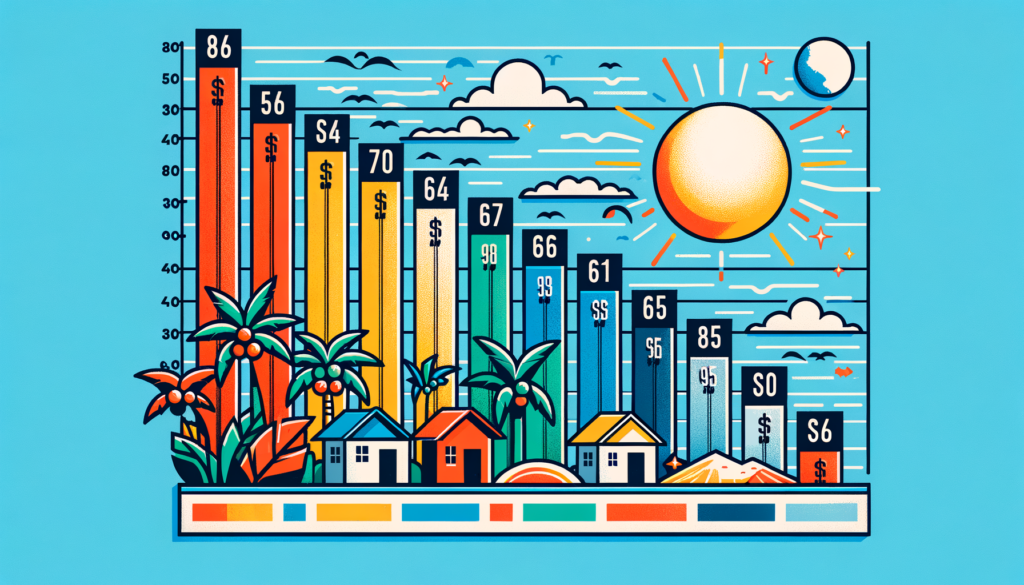Florida, synonymous with sunshine and storm watches, has experienced an unusually mild hurricane season in 2023. This gentle respite has brought about a sense of relief among its residents and triggered a notable dip in home insurance rates. The unexpected calm has sparked discussions among meteorologists, economists, and homeowners alike, as it presents an opportunity to re-evaluate the immediate and long-term implications of weather patterns in the state. By analyzing the seasonal trends, insurance adjustments, and economic consequences, we delve into the quieter-than-usual hurricane season and its impact on Florida’s homeowners.
Florida’s Quiet Year: A Hurricane Season Review
The 2023 hurricane season in Florida has been remarkably subdued, with fewer tropical storms making landfall than in previous years. Meteorologists have noted a significant decrease in the formation of substantial weather systems that typically threaten the Florida coast. This unexpected calm has reduced state-wide storm preparations and allowed residents to enjoy a more stable year without the usual anxiety of impending hurricanes. Furthermore, the absence of major hurricanes has kept the emergency response systems untested but ready. This development has highlighted the efficiency and preparedness of the state’s infrastructure for when anyone would need it.
Florida has endured numerous storms in previous years, taxing public resources and private homeowners. The 2023 season, however, contrasts starkly against the norm, with only a handful of named storms making it into the Gulf. Forecasters attribute this drop in activity to several atmospheric factors, including the El Niño effect, which typically suppresses hurricane formation in the Atlantic. Such weather phenomena create a natural shield that prevents storms from gaining the intensity needed to reach the Florida coast, offering residents a reprieve from evacuations and property damage.
Local governments have used this calm period to reflect on past hurricane seasons and improve future preparedness plans. Without the immediate pressure of incoming storms, resources were redirected toward community education and infrastructure reinforcement, ensuring that individuals and systems are better prepared when storms inevitably return. The state’s focus on resilience-building during the downtime has been prudent, allowing for implementing lessons learned from past years while the skies remain clear.
This year’s quiet hurricane season has also provided an unexpected economic advantage for the state. The redirection of funds from emergency response to long-term infrastructure investments has bolstered community resilience. In a state where hurricanes frequently disrupt the economy, the 2023 season has allowed Florida to allocate resources more efficiently, ensuring that businesses and individuals are better equipped to handle future storms. This strategic focus on reinforcement over recovery could set a new standard for Florida’s approach to managing hurricane impacts.
Analyzing the Gentle Weather Patterns in 2023
The mild weather patterns observed in 2023 have intrigued meteorologists and climate scientists, prompting a deeper examination of the factors contributing to this anomaly. Central to this phenomenon is El Niño, a climate event characterized by warming ocean surface temperatures in the Pacific. This warming disrupts typical atmospheric conditions, often leading to a reduction in hurricane activity in the Atlantic. As a result, Florida has seen fewer storms that could cause significant damage, offering a rare pause in the otherwise relentless cycle of tropical disturbances.
Apart from El Niño, other meteorological factors have contributed to the subdued hurricane season. Wind shear, for example, has been stronger than usual, disrupting the formation of storm systems by tearing apart the vertical structure of developing hurricanes. This atmospheric condition has been a key player in reducing the intensity and frequency of storms that could impact Florida. Additionally, cooler sea surface temperatures in parts of the Atlantic have further hindered storm development, contributing to the gentle weather patterns observed throughout the year.
Combining these meteorological factors presents a unique opportunity for researchers to study the complex interactions between climate phenomena and storm activity. The insights gained could prove invaluable in refining predictive models and enhancing the accuracy of long-term weather forecasts. By understanding the underlying causes of this year’s mild season, scientists can better anticipate future hurricane patterns and help mitigate their impact on coastal regions like Florida, where the economic and social stakes are exceptionally high.
While the 2023 hurricane season has been notably gentle, it serves as a reminder of the unpredictable nature of weather systems. The interplay of different climate factors can lead to significant variations yearly, making it crucial for Florida to remain vigilant. Ongoing research and meteorological advancements will be essential in preparing for future seasons, ensuring that the state remains ready for more turbulent weather even in the face of a quiet year. The lessons learned from this year’s gentle patterns will undoubtedly inform strategies to safeguard Florida’s communities in years to come.
Homeowners Benefit from Favorable Storm Trends
For homeowners across Florida, the mild hurricane season of 2023 has translated into reduced stress and financial relief. The absence of significant storms has meant less property damage and the subsequent need for costly repairs. Homeowners, particularly those in high-risk coastal areas, have expressed gratitude for the unexpected tranquility, allowing them to avoid the typical annual scramble to safeguard their homes and belongings against the threat of severe weather.
The calm season has also presented a rare opportunity for homeowners to focus on long-term property improvements. With the absence of immediate threats, many have invested in preventive measures. For example, wise updates such as installing hurricane-resistant windows and reinforcing roofs ensure they have better equipped their homes to withstand future storms. This proactive approach enhances property resilience and contributes to a broader culture of preparedness within communities, fostering a sense of collective security and readiness.
In addition to the physical and psychological benefits, homeowners have also enjoyed financial advantages due to the mild hurricane season. With homeowners filing fewer claims, insurance companies have been able to lower their coverage rates, offering policyholders more affordable options. This reduction in insurance costs has provided much-needed financial relief to many families, enabling them to allocate funds towards other priorities such as home improvements, savings, or debt reduction. The economic ripple effect of lower insurance rates is felt across the state, contributing to a more robust and resilient financial landscape.
The favorable storm trends of 2023 have also encouraged homeowners to reconsider their insurance strategies. With the present calm, many have shopped around for better policies, reassessing their coverage needs and exploring options that offer more comprehensive protection at competitive rates. This shift in consumer behavior reflects a growing awareness of the importance of adequate insurance coverage, even in the face of a mild season, ensuring that homeowners remain safeguarded against the unpredictable nature of future weather events.
Insurance Rates Drop Due to Fewer Hurricanes
The quieter hurricane season has directly impacted the insurance industry, decreasing home insurance rates across Florida. With fewer storms causing damage, insurance companies have faced fewer claims. This decrease in claims has allowed insurers to pass on savings to consumers through lower premiums. Homeowners, particularly those in high-risk areas, have welcomed this development, as it offers them a rare financial reprieve in a state where insurance costs are notoriously high.
The reduction in insurance rates reflects the insurance industry’s responsiveness to the decreased risk of claims during the 2023 hurricane season. Insurers are keenly aware of seasonal trends and adjust their pricing strategies based on the likelihood of weather-related claims. This year’s gentle weather patterns have allowed them to recalibrate their models and offer more competitive rates to policyholders, helping to ease the financial burden on Florida homeowners.
However, this rate reduction will likely be temporary, contingent on continuing favorable weather patterns. Both insurers and homeowners know that a single season of mild weather does not negate the historical risks of living in a hurricane-prone region. As such, while homeowners enjoy the current financial benefits, an underlying understanding remains that insurance premiums may rise again in future seasons should storm activity increase.
The decreased insurance rates also allow homeowners to re-evaluate their coverage needs. With more affordable options available, many policyholders opt to enhance their coverage, ensuring they are well-protected in future storms. This strategic move represents a growing awareness of the importance of comprehensive insurance, even during a calm season, as homeowners recognize the unpredictable nature of Florida’s weather patterns and the necessity of being prepared for the future.
Economic Impacts of a Mild Hurricane Season
The mild hurricane season of 2023 has had far-reaching economic impacts across Florida, easing financial pressures on individuals and the state. With fewer storms, the costs associated with emergency preparedness, response, and recovery efforts have significantly decreased, allowing the state to reallocate funds to other critical areas such as infrastructure improvements, education, and healthcare. This financial reprieve has permitted Florida to strengthen its economic foundations, enhancing its resilience against future challenges.
For businesses, the absence of disruptive storms has meant uninterrupted operations and stability in revenue streams. Sectors that typically suffer during hurricane season, such as tourism and retail, have experienced a boost as visitors have flocked to the state, confident in the favorable weather. This increase in tourism has generated a positive ripple effect, benefiting local economies and providing a welcome boost to small businesses that rely on seasonal traffic. The economic stability afforded by the mild season has allowed companies to focus on growth and expansion, contributing to a more robust state economy.
The housing market has also felt the positive effects of a gentle hurricane season. With reduced risk of storm damage, property values in coastal areas have remained stable or even increased, providing homeowners with more significant equity and confidence in their investments. This stability has encouraged real estate activity, with buyers and sellers engaging in transactions without the looming threat of hurricanes. Additionally, reducing insurance rates has made homeownership more accessible, attracting new buyers and further stimulating the housing market.
Conclusion
The benefits of this mild hurricane season go beyond financial savings. It has fostered a sense of community resilience and optimism among Floridians. The decreased pressure has allowed residents to focus on improving their homes and neighborhoods, turning a season of anxiety into one of growth and renewal. Additionally, with more affordable home insurance rates, prospective buyers are more encouraged to enter the market, leading to a more robust real estate landscape. This year has shown that sometimes, calm winds can bring about the most significant changes, setting a precedent for future seasons where preparation meets opportunity in the best possible way.



